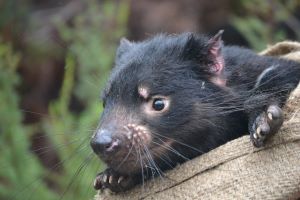Submitted by Lorraine Leonard on Fri, 21/04/2023 - 08:22
Tasmanian devils, marsupial carnivores endemic to the Australian island of Tasmania, are susceptible to two transmissible cancers, known as devil facial tumour 1 (DFT1) and devil facial tumour 2 (DFT2). A new study from the Transmissible Cancer Group at the Department of Veterinary Medicine, published today in Science, investigated the evolution of DFT1 and DFT2.
Cancer arises when cells of the body acquire mutations which cause them to grow uncontrollably and to invade and disrupt tissues. Cancer is usually not a transmissible disease, however; cancer cells cannot normally spread from one person or animal to another. Transmissible cancer is an unusual form of cancer which occurs when cancer cells themselves spread between individuals as infectious agents. Transmissible cancer only affects animals, not people, and is moreover rare in the animal kingdom. Tasmanian devils are unusual in having two transmissible cancers, suggesting that this species is particularly vulnerable to this form of disease.
The presence of two transmissible cancers in Tasmanian devils gives an opportunity to compare the evolution of the two independent transmissible cancer clones. The authors started by creating an improved reference genome for the Tasmanian devil. By mapping the mutations in 119 DFT1 and DFT2 tumours, the researchers created transmission trees for the two cancers. These revealed that the two cancers first arose in ~1986 (DFT1) and ~2011 (DFT2). Unexpectedly, DFT2 was found to accumulate mutations around three times faster than DFT1, suggesting that it may be an intrinsically faster-dividing cell line. The researchers pinpointed mutations which may be important in driving tumour growth.
Overall, the study highlights the unpredictable threat that transmissible cancers pose to Tasmanian devils, underlining the continuing importance of ongoing Tasmanian devil conservation efforts.
Congratulations to Maximilian Stammnitz, study first author, and to the wonderful team of collaborators from Tasmania and around the world!
The research was funded by Wellcome.
Image credit: Maximilian Stammnitz

